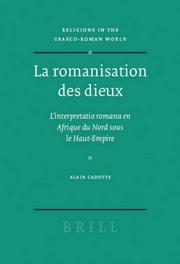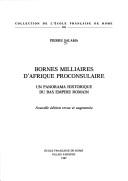| Listing 1 - 7 of 7 |
Sort by
|
Book
ISBN: 9781887829762 1887829768 Year: 2009 Volume: 76 Publisher: Portsmouth, RI Journal of Roman archaeology
Abstract | Keywords | Export | Availability | Bookmark
 Loading...
Loading...Choose an application
- Reference Manager
- EndNote
- RefWorks (Direct export to RefWorks)
Pottery, Roman --- Céramique romaine --- Bonifay, Michel. --- Africa (Roman province) --- Afrique (Province romaine) --- Antiquities, Roman --- Antiquities --- Antiquités romaines --- Antiquités --- Festschrift - Libri Amicorum --- Antiquities, Roman. --- Antiquities. --- Céramique romaine --- Antiquités romaines --- Antiquités --- Roman pottery --- Terra-sigillata (Pottery) --- Classical antiquities --- Pottery, Classical --- Afrique (Roman province)
Book
ISBN: 8886655924 9788886655927 Year: 2001 Volume: 116 Publisher: Roma: Ed. Liturgiche,
Abstract | Keywords | Export | Availability | Bookmark
 Loading...
Loading...Choose an application
- Reference Manager
- EndNote
- RefWorks (Direct export to RefWorks)
Baptism (Liturgy) --- Lord's Supper (Liturgy) --- History --- 264.025 --- 276 =71 OPTATUS MILEVITANUS --- #GOSA:II.P.OPT.M --- Afrikaanse ritus --- Latijnse patrologie--OPTATUS MILEVITANUS --- 264.025 Afrikaanse ritus --- Anaphora (Liturgy) --- Lord's Supper --- Liturgics --- Baptism --- Sacraments (Liturgy) --- Liturgy --- Optatus, --- Optat, --- Ottato, --- Africa (Roman province) --- Afrique (Roman province) --- Church history. --- Baptism (Liturgy) - History - To 1500. --- Lord's Supper (Liturgy) - History - To 1500.

ISSN: 09277633 ISBN: 1281400017 9786611400019 9047410335 9789047410331 900415258X 9789004152588 Year: 2007 Volume: 158 Publisher: Leiden Boston Brill
Abstract | Keywords | Export | Availability | Bookmark
 Loading...
Loading...Choose an application
- Reference Manager
- EndNote
- RefWorks (Direct export to RefWorks)
Heirs to the Punic and Berber traditions, the North Africans, once conquered by the Romans and willing to show respect for their new masters’ gods, did not want to forsake their beloved ancestral deities and solved this dilemma by giving Roman names to their traditional gods, who nevertheless kept most of their former natures. This phenomenon, known as interpretatio romana, resulted in an interpenetration of both religious universes, each being enriched in the process. Roman African gods thus conceal dual personalities within themselves, which this book tries to investigate through all available sources (epigraphy, literature, numismatic and archaeology), unveiling many unsuspected aspects of great deities like Saturn/Baal Hammon, Astarte/Venus or Mercury/Baal Addir. If those gods of Roman Africa have inspired many individual studies, there was still a need for a book examining them all together within their interrelations. Here is then at last a real global study of the Roman-African pantheon. *** Héritiers des traditions puniques et berbères, les Nord-africains, à l’arrivée du conquérant romain, voulurent conserver leurs divinités ancestrales tout en respectant les dieux de leur nouveau maître. Ils affublèrent donc de noms romains leurs dieux traditionnels tout en leur conservant l’essentiel de leur personnalité d’origine. Ce phénomène, connu sous le terme d’ , résulta en une interpénétration des deux univers religieux, qui s’enrichirent ainsi mutuellement. Les dieux de l’Afrique romaine cachent donc des personnalités multiples que cet ouvrage tente de dévoiler en mettant à profit toutes les sources disponibles : épigraphie, littérature, numismatique et archéologie. Ces grandes divinités, telles que Saturne/Baal Hammon, Vénus/Astarté ou Mercure/Baal Addir livrent ainsi tour à tour des aspects insoupçonnés de leurs personnalités. Si les dieux d’Afrique romaine ont suscité diverses études individuelles, il manquait encore un ouvrage qui les examinerait tous ensemble et dans leurs rapports entre eux. Voici donc enfin une véritable étude globale du panthéon romano-africain.
Gods, Roman --- Gods, Punic. --- Gods, Roman. --- Religion. --- Carthaginian gods --- Gods, Carthaginian --- Punic gods --- Roman gods --- Religion, Primitive --- Atheism --- God --- Irreligion --- Religions --- Theology --- Africa (Roman province) --- Africa (Roman Province) --- Afrique (Roman province) --- Afrique --- Gods, Punic --- 292.07 --- Religion Classical Roman --- Dieux puniques --- Dieux romains --- Afrique (Province romaine) --- Religion --- Gods, Roman - Africa (Roman province)

ISBN: 2728301336 9782728301331 Year: 1987 Volume: 101 Publisher: Rome: École française de Rome,
Abstract | Keywords | Export | Availability | Bookmark
 Loading...
Loading...Choose an application
- Reference Manager
- EndNote
- RefWorks (Direct export to RefWorks)
Boundary stones --- Bornes --- Rome --- Africa, North --- Afrique du Nord --- Boundaries --- Antiquities, Roman --- Frontières --- Antiquités romaines --- Milestones --- Romans --- Africa (Roman province) --- -Romans --- -#GOSA:II.P.AU.1 --- Ethnology --- Italic peoples --- Latini (Italic people) --- Mileposts --- Street signs --- -Antiquities, Roman --- Frontières --- Antiquités romaines --- #GOSA:II.P.AU.1 --- Afrique (Roman province) --- Antiquities, Roman. --- Mile pillars --- Pillars, Mile --- Milestones - Africa, North --- Romans - Africa, North --- Africa (Roman province) - Antiquities, Roman
Book
ISBN: 0860549623 Year: 1998 Volume: 724 Publisher: Oxford : Hedges,
Abstract | Keywords | Export | Availability | Bookmark
 Loading...
Loading...Choose an application
- Reference Manager
- EndNote
- RefWorks (Direct export to RefWorks)
Priests --- Inscriptions, Latin --- Priesthood --- Prêtres --- Inscriptions latines --- Sacerdoce --- History. --- Catalogs. --- History of doctrines. --- Histoire --- Catalogues --- Histoire des doctrines --- Andalusia (Spain) --- Africa (Roman province) --- Rome --- Andalousie (Espagne) --- Afrique (Province romaine) --- Religion. --- History --- Religion --- -Inscriptions, Latin --- -Priesthood --- -Priests --- -Pastors --- Clergy --- Christian priesthood --- Ordination --- Latin inscriptions --- Latin language --- Latin philology --- History of doctrines --- -Andalusia (Spain) --- -Rome --- -History of doctrines --- Prêtres --- Pastors --- Andalucía (Spain) --- Andalousie (Spain) --- Andalusien (Spain) --- Autonomous Community of Andalusia (Spain) --- Communauté autonome d'Andalousie (Spain) --- Comunidad Autónoma de Andalucía (Spain) --- Baetica (Spain) --- Junta de Andalucía (Spain) --- Andalus (Spain) --- Bética --- Al-Andalus --- Afrique (Roman province)

ISBN: 3110181843 3110913461 9783110181845 Year: 2004 Volume: 140 Publisher: Berlin: de Gruyter,
Abstract | Keywords | Export | Availability | Bookmark
 Loading...
Loading...Choose an application
- Reference Manager
- EndNote
- RefWorks (Direct export to RefWorks)
"Perpetua and the Egyptian", the first comprehensive literary interpretation of an early Christian martyrdom text, the Passio Perpetuae, is important not only for patristic scholars, classicists and literary historians, but also - and especially - for all those working on the position of women in classical antiquity. This revised edition deals particularly with the literature which has appeared over the past decade and goes into more detail of the functions and addressees of the Passio in the African Church community of the early 3rd century. "Perpetua und der Ägypter", die erste umfassende literarische Deutung eines frühchristlichen Märtyrertextes, der Passio Perpetuae, ist nicht allein für Patristiker, Klassische Philologen und Literaturwissenschaftler von Belang, sondern auch und gerade für alle, die zur Geschichte der Frau in der Antike arbeiten. Die Überarbeitung setzt sich vor allem mit der Literatur auseinander, die in der vergangenen Dekade erschienen ist, und geht noch genauer auf die Aufgaben und Adressaten der Passio in der afrikanischen Gemeinde des frühen 3. Jh. ein.
Christelijke hagiografie --- Christian hagiography --- Hagiographie chrétienne --- Heiligenlevens --- Christian martyrs --- Christian women saints --- Christian saints --- Biography --- History and criticism --- Perpetua, --- Passio SS Perpetuae et Felicitatis --- Africa (Roman province) --- Church history --- Perpetua --- Passio Sanctarum Perpetuae et Felicitatis --- Primitive and early church, ca. 30-600 A.D. --- Sources --- Early works to 1800 --- Africa [North ] --- Good and evil --- Religious aspects --- Christianity --- Christian hagiography. --- History and criticism. --- Christianity. --- Passio SS. Perpetuae et Felicitatis. --- Church history. --- Saints --- Canonization --- Hagiography, Christian --- Hagiography --- Christian saints, Women --- Women Christian saints --- Women saints --- Martyrs --- Martyrdom --- Perpétue, --- Vibia Perpetua, --- Passio S. Perpetuae --- Passio Sanctae Perpetuae --- Passio Perpetuae et Felicitatis --- Passion des saintes Perpétue et Félicité --- Passion of S. Perpetua --- Passion of St. Perpetua --- Passion of SS. Perpetua and Felicity MM. --- Passion of Saints Perpetua and Felicitas --- Afrique (Roman province) --- Christian martyrs - Africa (Roman province) - Biography - Early works to 1800 --- Christian martyrs - Biography - Early works to 1800 --- Christian women saints - Biography - Early works to 1800 --- Christian saints - Biography - History and criticism --- Perpetua, - Saint, - -203 --- Africa (Roman province) - Church history --- Perpétue --- Vibia Perpetua
Book
ISBN: 9781433108044 Year: 2011 Volume: 10 Publisher: Frankfurt am Main [etc.] Peter Lang
Abstract | Keywords | Export | Availability | Bookmark
 Loading...
Loading...Choose an application
- Reference Manager
- EndNote
- RefWorks (Direct export to RefWorks)
276 =71 AUGUSTINUS --- 27 "03"/04" --- 27 <61> --- Latijnse patrologie--AUGUSTINUS --- Kerkgeschiedenis --- Kerkgeschiedenis--Noord-Afrikaanse Staten. Maghreb. Noord-Afrika --- Augustine, --- Avgustin, Blazhennyĭ, --- Augustinus, Aurelius, --- Augustyn, --- Augustin, --- Ughasṭīnūs, --- Agostino, --- Agustí, --- Augoustinos, --- Agostino di Tagaste, --- Aurelius Augustinus, --- Augustinus, --- Agostino d'Ippona, --- Agustín, --- Aurelio Agostino, --- Episkopos Ippōnos Augoustinos --- Augoustinos Ipponos --- Agostinho, --- Aurelli Augustini, --- Augustini, Aurelli, --- Aurelii Augustini, --- Augustini, Aurelii, --- Ōgostinos, --- Agostino, Aurelio, --- אוגוסטינוס הקדוש --- أغسطينوس، --- 奥古斯丁 --- Agustín de Hipona --- San Agustín --- Augustin d'Hippone --- Pseudo-Augustinus --- Sermons --- -History and criticism. --- Catholic Church --- -Church of Rome --- Roman Catholic Church --- Katholische Kirche --- Katolyt︠s︡ʹka t︠s︡erkva --- Römisch-Katholische Kirche --- Römische Kirche --- Ecclesia Catholica --- Eglise catholique --- Eglise catholique-romaine --- Katolicheskai︠a︡ t︠s︡erkovʹ --- Chiesa cattolica --- Iglesia Católica --- Kościół Katolicki --- Katolicki Kościół --- Kościół Rzymskokatolicki --- Nihon Katorikku Kyōkai --- Katholikē Ekklēsia --- Gereja Katolik --- Kenesiyah ha-Ḳatolit --- Kanisa Katoliki --- כנסיה הקתולית --- כנסייה הקתולית --- 가톨릭교 --- 천주교 --- Africa (Roman province) --- -Church history. --- -Africa (Roman province) --- Episkopos Ippōnos Augoustinos, --- Augoustinos Ipponos, --- History and criticism. --- Afrique (Roman province) --- Church history. --- Avgustin, --- Augustinus, Aurelius --- Agostinho --- Augustine of Hippo --- Augustine d'Hippone --- Agostino d'Ippona --- Augustinus Hipponensis, sanctus --- Sant'Agostino --- Augustinus van Hippo --- Aurelius Augustinus --- Aurelio Agostino --- 聖アウグスティヌス --- アウグスティヌス --- Augustine --- Church of Rome
| Listing 1 - 7 of 7 |
Sort by
|

 Search
Search Feedback
Feedback About UniCat
About UniCat  Help
Help News
News